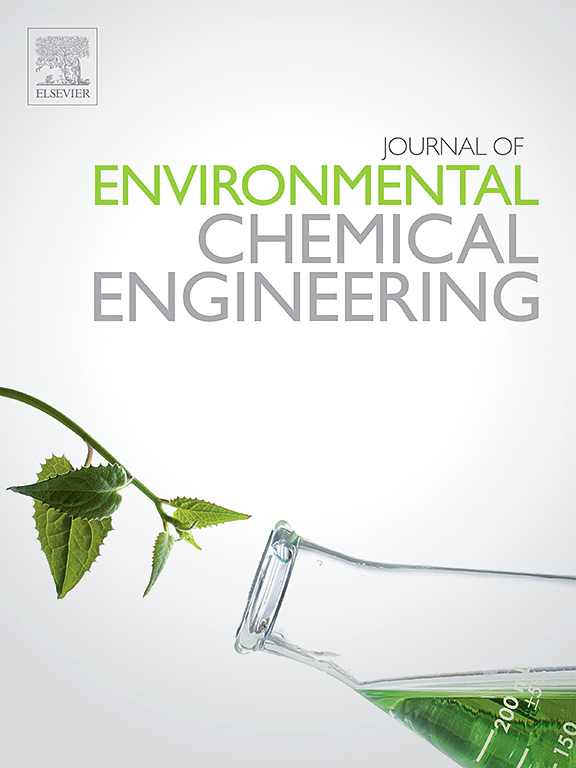IF 7.4
2区 工程技术
Q1 ENGINEERING, CHEMICAL
引用次数: 0
摘要
一氧化碳(CO)是一种重要的化学原料,广泛应用于各种工业流程,如费托合成和水气变换反应等,凸显了其在化学工业中的重要作用。光催化二氧化碳还原生成一氧化碳为将无用的温室气体转化为有价值的化学原料提供了一条极具吸引力的途径。考虑到光催化二氧化碳转化的选择性较差以及混合产物分离的复杂性,首次提出了将沸石与半导体光催化剂相结合以实现高选择性二氧化碳光还原的方法。本文选择了具有高比表面积和优异二氧化碳亲和性的硅铝酸盐-1沸石,通过简便的热聚合过程构建了氮化石墨碳/硅铝酸盐-1(CN/S-1)复合材料。引入的 S-1 沸石能够延长可见光响应时间、增强二氧化碳吸附能力、促进光激发电荷载流子在 CN/S-1 复合材料中的分离和传输。所制备的 CN/S-1 复合材料显著提高了光催化还原 CO2 的活性,产生的 CO 和 CH4 分别为 452.8 μmol-h-1 和 11.63 μmol-h-1。CN/S-1 复合材料的 CO 选择性达到了 97.5%,是迄今为止基于 CN 的光催化剂中最高的。原位傅立叶变换红外光谱表征显示,在加入 S-1 沸石后,复合材料更倾向于将 COOH* 分解为 CO,而不是质子化为氢化产物。本文章由计算机程序翻译,如有差异,请以英文原文为准。
Silicalite-1 zeolite enables graphitic carbon nitride high selectivity toward CO2 photoreduction
Carbon monoxide (CO) constitutes a pivotal chemical feedstock, extensively applied in diverse industrial processes such as the Fischer–Tropsch synthesis and the water-gas shift reaction, among others, underscoring its significant role in the chemical industry. Photocatalytic CO2 reduction to produce CO provides an appealing route to consume useless greenhouse gases to valuable chemical feedstock. Regarding the poor selectivity of photocatalytic CO2 conversion and the separation complexity for mixed products, integrating zeolite with semiconductor photocatalyst is first presented to achieve highly selective CO2 photoreduction. Herein, silicalite-1 zeolite with high surface area and excellent CO2 affinity is selected to construct a graphitic carbon nitride/silicalite-1 (CN/S-1) composite via a facile thermal polymerization procedure. The introduced S-1 zeolite enables extended visible light response, enhanced CO2 adsorption, promoted separation and transportation of photoexcited charge carriers for the as-synthesized CN/S-1 composite. The resulting CN/S-1 composite shows significantly improved photocatalytic CO2 reduction activity, yielding CO and CH4 of 452.8 and 11.63 μmol·h−1, respectively. The CO selectivity of the CN/S-1 composite achieves 97.5 %, which is maximal so far among the CN-based photocatalysts. In-situ Fourier transformed infrared (in-situ FTIR) spectra characterization reveals the composite prefer to dissociate COOH* to CO upon the incorporation of S-1 zeolite rather than protonation into hydrogenation products.
求助全文
通过发布文献求助,成功后即可免费获取论文全文。
去求助
来源期刊

Journal of Environmental Chemical Engineering
Environmental Science-Pollution
CiteScore
11.40
自引率
6.50%
发文量
2017
审稿时长
27 days
期刊介绍:
The Journal of Environmental Chemical Engineering (JECE) serves as a platform for the dissemination of original and innovative research focusing on the advancement of environmentally-friendly, sustainable technologies. JECE emphasizes the transition towards a carbon-neutral circular economy and a self-sufficient bio-based economy. Topics covered include soil, water, wastewater, and air decontamination; pollution monitoring, prevention, and control; advanced analytics, sensors, impact and risk assessment methodologies in environmental chemical engineering; resource recovery (water, nutrients, materials, energy); industrial ecology; valorization of waste streams; waste management (including e-waste); climate-water-energy-food nexus; novel materials for environmental, chemical, and energy applications; sustainability and environmental safety; water digitalization, water data science, and machine learning; process integration and intensification; recent developments in green chemistry for synthesis, catalysis, and energy; and original research on contaminants of emerging concern, persistent chemicals, and priority substances, including microplastics, nanoplastics, nanomaterials, micropollutants, antimicrobial resistance genes, and emerging pathogens (viruses, bacteria, parasites) of environmental significance.
 求助内容:
求助内容: 应助结果提醒方式:
应助结果提醒方式:


